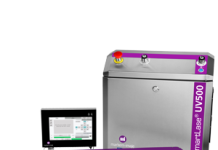Konica Minolta discussed trends in the printing industry during a drupa preview webinar. The webinar was hosted by Joerg Hartmann, president and managing director at Konica Minolta Business Solutions Germany and Austria, who said that by looking at print from a different angle, print’s strengths and weaknesses can be reevaluated.
Headlining the webinar was Oliver Becker, head of professional printing, Konica Minolta Business Solutions Deutschland GmbH. Some of the trends Becker discussed, particularly from a Covid-19 perspective, was that the retail, consumer, tourism and events sector have been hit hard. Moreover there has been a shift from classic print to digital, and the pandemic is accelerating this trend. The longer this lasts, the more people will depend on digital. Becker also mentioned that today people are less willing to invest in technological innovations, and are waiting for something to be a proven technology, rather than a first.
However, Konica Minolta are firm believers that print matters and adds value, and are working closely with customers to create the best solution. Becker said that using a whole team from Konica Minolta to work with customers is one of the best solutions, as well as technical training for the customer’s trust, safety and flexibility, which is facilitated by Konica Minolta’s training academy. ‘Support is key before, during and after the product purchase,’ said Becker.
Another emerging trend is Augmented Reality (AR), which features lower cost and unique selling propositions. ‘Similar to the combination of print, embellishing and shaping, the use of AR creates completely new markets that were previously unimaginable,’ said Becker. To exemplify he mentioned using the company’s geARate technology.
‘Whether you are an agency, publisher or copy shop owner, genARate gives you the power to overlay video, animations or 3D models onto printed materials to create rich media communications,’ he said. ‘The technology offers many opportunities, especially for smaller businesses that are looking for something new with a unique selling proposition.’
Thorsten Kinnen, business development manager for commercial printing at Konica Minolta Business Solutions Deutschland GmbH mentioned that some other trends, which have been around before the onset of the pandemic but have gained new energy, include:
– Process optimisation: many customers have tried to streamline their processes in order to generate missing capital through cost savings or to counteract the pressure on prices.
– Greater specialisation: in many cases it has been shown that smaller companies in particular can survive in competition with the growing online businesses by specialising. Cooperation and individual services form the basis of their success. For example, they operate strongly in local markets or in areas that can only be scaled to a limited extent.
– New technologies for new markets: when traditional markets are shrinking, one strategy can also be to expand. Printed electronics, smart packaging, video and/or audio in print or 3D printing are ready to expand the world of print,. ‘These technologies are bridges into the digital world,’ said Kinnen. ‘For example, AR combines the advantages of a haptic print product with the topicalities and possibilities of digital content. These bridges are vital and thus we have to rethink the limit of prints and reshape them. Enrich the well-known and established print product with the new features that go beyond these.’
– Switching from traditional printing technology such as sheetfed offset,to digital printing technology: ‘The issue of decreasing print runs and the resulting inefficiency of production is nothing new, but the increasing range of solutions and technologies only raises more questions,’ he said.
He further illustrated these trends by discussing the company’s solutions that are built around speed and production of products, precision, range and ease of use. Optimally tailored workflow solutions prepare customers for current and future scenarios.
Other factors for growth and success include the response to the individual needs of customers as well as understanding the importance of virtual showrooms and remote support/service. ‘This saves valuable time and ensures the customer’s productivity and success,’ concluded Kinnen.
KONICA MINOLTA
https://www.konicaminolta.eu/eu-en





















